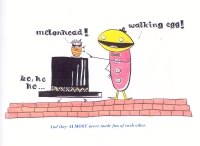| ________________
CM . . .
. Volume XIV Number 8 . . . . December 7, 2007
excerpt:
When social courtesy means tipping your hat when you greet people, Mr. Tadaa’s large head causes him no end of grief. His inability to find his hat (little less tip it) results in others becoming frustrated and making fun of Mr. Tadaa. Luckily, a fateful wind blows Mr. Tadaa’s small hat into the little person’s life, and the little person’s big hat into Mr. Tadaa’s life. However, the hats don’t seem to solve both character’s problems as the big hat is too big for Mr. Tadaa, and the little person realizes he doesn’t like wearing a small hat! Fortunately, all works out for the best as the characters discover how similar their problems are, and they draw upon their newfound friendship to boldly and cheerfully face further sticky social situations. This is the first children’s book for Canadian author/illustrator Lisa Cinar, and I am delighted to report that she has produced a story which cleverly and humorously grapples with the topic of social and cultural homogeneity. The story presents the struggles of four characters whose uniqueness is ridiculed because their actions and physical traits are outside of the norm. Such a story taps into the very real possibility that children have either experienced, or fear they will experience, social situations where they find their uniqueness - their differences – to be limiting and/or open to ridicule from others. Although the characters are drawn and act in a delightfully whimsical manner, most readers will be able to relate to the characters’ emotional upheavals, and respond positively to Cinar’s hopeful message that through human compassion and friendship, understandings can be forged that value and celebrate the uniqueness and creativity of every human being. However, some parents and educators may take exception to the name-calling Mr. Tadaa and the little person direct at each other near the end of the book. Even though the name-calling is done in fun (and could be used by adults to help children begin understanding the importance of being able to laugh at one’s own mistakes and shortfalls), some adults may find this page gives readers too much permission to participate in an activity that counteracts some parents’ and educators’ anti bullying and compassion curriculum. The full impact of the story’s significance, however, falters near the end when it presents a mixed message. At story-end, the four newfound friends (Mr. Tadaa, Ahh, little person, and the small hat) stop tipping their hats altogether and choose to greet other people with smiles. Sometimes their smiles are met with rude remarks, and the friends respond by screaming, “Tip, Ahhhhhhh, Tip!” at the top of their lungs which “would shock and confuse the frustrated hat tipper.” Thinking this shock treatment to be hilarious, the four friends “fall down laughing, until their faces were all stretched out and their stomachs hurt.” This tactic of the four friends’ finding strength by shocking and laughing at others could leave readers with a confusing message. That is, although it was wrong for people to laugh and make fun of Mr. Tadaa and the little person, it is appropriate for Mr. Tadaa and the little person to find strength in shocking and laughing at others. Understandably, the ‘normal’ people who are rude to the four friends are the characters who really need to learn to be understanding and compassionate, but some readers may question whether the friends’ actions are the best choice of methods for teaching it. A discussion of the friends’ actions at the end of this text would help clarify this mixed message.
The illustrations are created with water colours and Indian ink. They are simple, clear and colorful, and the characters are very funny and animated. The facial features of Mr. Tadaa and the little person clearly illustrate their feelings and can be used with younger children to talk about how the characters feel when they’re being bullied or when they’re bullying. The visual flow of the book is far from static, employs a great many page layout formats, and is somewhat reflective of Cinar’s non-children’s-book art (see http://www.lisacinar.com). At several points in the story, the characters turn and face the reader and engage the reader visually through a greeting or by asking the reader a question. This visual interaction adds another level of enjoyment to the story. The two children to whom I read this book enjoyed the characters so much they continued drawing them on their own, and one even illustrated some of their own adventures of Mr. Tadaa and Ahh. The Day It All Blew Away affirms, celebrates and supports human uniqueness; a message sorely needed help counteract the conformity messages in much of today’s modern media for children (TV: everyone should be like Barbie, Video Games: Everyone needs to be this kind of consumer!). Although this message is somewhat hindered by several inconsistencies in the story, follow-up discussions can alleviate many of these concerns. The illustrations will likely draw many delighted titters from the readers, and the celebration of personal difference will ring true with many children and thus fast become a ‘favourite read.’ Recommended. Keith McPherson has been a primary and elementary teacher and teacher-librarian in BC since 1984 and is currently the coordinator of the Language and Literacy Education Research Centre at the University of B.C.
To comment on this
title or this review, send mail to cm@umanitoba.ca.
Copyright © the Manitoba Library Association. Reproduction for personal
use is permitted only if this copyright notice is maintained. Any
other reproduction is prohibited without permission.
NEXT REVIEW |TABLE OF CONTENTS FOR THIS ISSUE
- December 7, 2007. AUTHORS
| TITLES | MEDIA REVIEWS
| PROFILES
| BACK ISSUES
| SEARCH | CMARCHIVE
| HOME |

